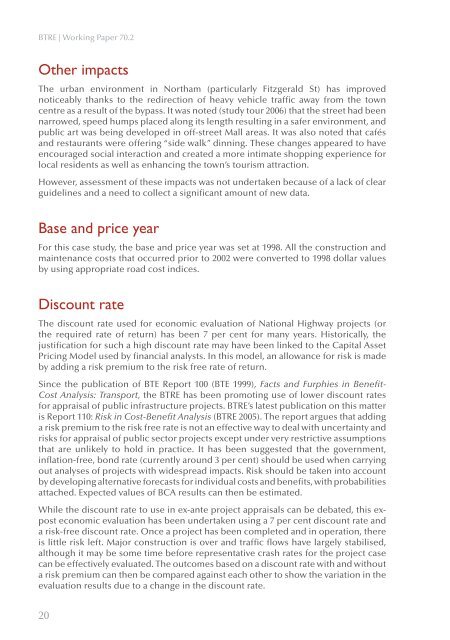PDF: 667 KB - Bureau of Infrastructure, Transport and Regional ...
PDF: 667 KB - Bureau of Infrastructure, Transport and Regional ...
PDF: 667 KB - Bureau of Infrastructure, Transport and Regional ...
Create successful ePaper yourself
Turn your PDF publications into a flip-book with our unique Google optimized e-Paper software.
BTRE | Working Paper 70.2<br />
Other impacts<br />
The urban environment in Northam (particularly Fitzgerald St) has improved<br />
noticeably thanks to the redirection <strong>of</strong> heavy vehicle traffic away from the town<br />
centre as a result <strong>of</strong> the bypass. It was noted (study tour 2006) that the street had been<br />
narrowed, speed humps placed along its length resulting in a safer environment, <strong>and</strong><br />
public art was being developed in <strong>of</strong>f-street Mall areas. It was also noted that cafés<br />
<strong>and</strong> restaurants were <strong>of</strong>fering “side walk” dinning. These changes appeared to have<br />
encouraged social interaction <strong>and</strong> created a more intimate shopping experience for<br />
local residents as well as enhancing the town’s tourism attraction.<br />
However, assessment <strong>of</strong> these impacts was not undertaken because <strong>of</strong> a lack <strong>of</strong> clear<br />
guidelines <strong>and</strong> a need to collect a significant amount <strong>of</strong> new data.<br />
Base <strong>and</strong> price year<br />
For this case study, the base <strong>and</strong> price year was set at 1998. All the construction <strong>and</strong><br />
maintenance costs that occurred prior to 2002 were converted to 1998 dollar values<br />
by using appropriate road cost indices.<br />
Discount rate<br />
The discount rate used for economic evaluation <strong>of</strong> National Highway projects (or<br />
the required rate <strong>of</strong> return) has been 7 per cent for many years. Historically, the<br />
justification for such a high discount rate may have been linked to the Capital Asset<br />
Pricing Model used by financial analysts. In this model, an allowance for risk is made<br />
by adding a risk premium to the risk free rate <strong>of</strong> return.<br />
Since the publication <strong>of</strong> BTE Report 100 (BTE 1999), Facts <strong>and</strong> Furphies in Benefit-<br />
Cost Analysis: <strong>Transport</strong>, the BTRE has been promoting use <strong>of</strong> lower discount rates<br />
for appraisal <strong>of</strong> public infrastructure projects. BTRE’s latest publication on this matter<br />
is Report 110: Risk in Cost-Benefit Analysis (BTRE 2005). The report argues that adding<br />
a risk premium to the risk free rate is not an effective way to deal with uncertainty <strong>and</strong><br />
risks for appraisal <strong>of</strong> public sector projects except under very restrictive assumptions<br />
that are unlikely to hold in practice. It has been suggested that the government,<br />
inflation-free, bond rate (currently around 3 per cent) should be used when carrying<br />
out analyses <strong>of</strong> projects with widespread impacts. Risk should be taken into account<br />
by developing alternative forecasts for individual costs <strong>and</strong> benefits, with probabilities<br />
attached. Expected values <strong>of</strong> BCA results can then be estimated.<br />
While the discount rate to use in ex-ante project appraisals can be debated, this expost<br />
economic evaluation has been undertaken using a 7 per cent discount rate <strong>and</strong><br />
a risk-free discount rate. Once a project has been completed <strong>and</strong> in operation, there<br />
is little risk left. Major construction is over <strong>and</strong> traffic flows have largely stabilised,<br />
although it may be some time before representative crash rates for the project case<br />
can be effectively evaluated. The outcomes based on a discount rate with <strong>and</strong> without<br />
a risk premium can then be compared against each other to show the variation in the<br />
evaluation results due to a change in the discount rate.<br />
20

















